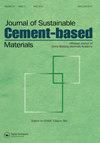不同固化条件下硅酸盐白云石水泥浆体的体积稳定性
IF 4.2
3区 工程技术
Q1 CONSTRUCTION & BUILDING TECHNOLOGY
Journal of Sustainable Cement-Based Materials
Pub Date : 2023-01-02
DOI:10.1080/21650373.2022.2161661
引用次数: 0
摘要
为了阐明白云石在高反应度下对硅酸盐白云石水泥(PDC)体积稳定性的影响,PDC浆体的长度随置换水平的变化为10-30 重量%白云石,并在不同条件下固化,与波特兰石灰石水泥(PLC)形成对比。利用XRD、TGA和SEM对水化产物和微观结构进行了研究。结果表明,在40和60 °C时,PDC和PLC显示出相似的变形模式,但有较小的膨胀。80岁 然而,在°C下,PDC的特点是比PLC具有更高的膨胀性,尤其是在高替换水平下。白云石在PDC中的反应过程取决于铝酸盐相的可用性。在游离氧化铝存在的情况下,白云石会优先反应形成碳铝酸盐、水滑石和方解石。当氧化铝耗尽时,就会发生去矿化反应,产生水镁石和方解石。PDC中的高膨胀主要与去矿化有关,由于水镁石和方解石在有限空间中的形成,去矿化可能导致增强框架体积和结晶压力。然而,PDC的膨胀太小,不会对硬化浆体造成损坏。因此,在PDC中掺入白云石对水泥基材料的体积稳定性没有不利影响。本文章由计算机程序翻译,如有差异,请以英文原文为准。
Volume stability of Portland-dolomite cement pastes cured in different conditions
For clarifying the effect of dolomite on the volume stability of Portland dolomite cement (PDC) at high reaction degree, the length change of PDC pastes with the replacement levels of 10–30 wt% dolomite and cured in different conditions was examined, in contrast with Portland limestone cement (PLC). The hydration products and microstructure were investigated using XRD, TGA, and SEM. Results indicate that at 40 and 60 °C the PDC and PLC show similar deformation patterns, with a small expansion. At 80 °C, however, the PDC are characterized by a higher expansion than the PLC, especially at high replacement levels. The reaction process of dolomite in PDC is dependent on the availability of aluminate phases. In the presence of free alumina, dolomite would react preferentially to form carboaluminates, hydrotalcite, and calcite. When the alumina is exhausted, dedolomitization reaction takes place producing brucite and calcite. The high expansion in PDC is mainly associated with the dedolomitization, which may result in the reinforcing frame volume and crystallization pressure due to the formation of brucite and calcite in confined space. However, the expansion of PDC is too small to cause damage to hardened pastes. Therefore, the incorporation of dolomite in PDC has no adverse effect on the volume stability of cement-based materials.
求助全文
通过发布文献求助,成功后即可免费获取论文全文。
去求助
来源期刊
CiteScore
6.60
自引率
15.90%
发文量
71
期刊介绍:
The Journal of Sustainable Cement-Based Materials aims to publish theoretical and applied researches on materials, products and structures that incorporate cement. The journal is a forum for discussion of research on manufacture, hydration and performance of cement-based materials; novel experimental techniques; the latest analytical and modelling methods; the examination and the diagnosis of real cement and concrete structures; and the potential for improved cement-based materials. The journal welcomes original research papers, major reviews, rapid communications and selected conference papers. The Journal of Sustainable Cement-Based Materials covers a wide range of topics within its subject category, including but are not limited to: • raw materials and manufacture of cement • mixing, rheology and hydration • admixtures • structural characteristics and performance of cement-based materials • characterisation techniques and modeling • use of fibre in cement based-materials • degradation and repair of cement-based materials • novel testing techniques and applications • waste management

 求助内容:
求助内容: 应助结果提醒方式:
应助结果提醒方式:


